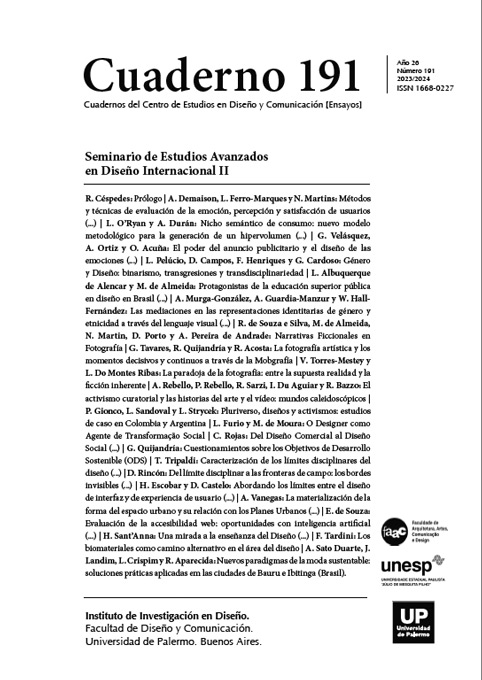Una mirada a la enseñanza del Diseño Computacional con el lenguaje RocketSocket
Palabras clave:
Diseño Computacional ; Pensamiento Computacional ; Principios de la Computación ; Teoría del Control Perceptual ; Método de Niveles
Resumen
El Diseño Computacional (DC) es un abordaje de proyecto cuyos productos son algoritmos que computan soluciones para problemas de interés del diseñador.
Citas
Brennan, K., & Resnick, M. (2012). New frameworks for studying and assessing the development of computational thinking. Proceedings of the 2012 annual meeting of the American educational research association, Vancouver, Canada, 1, 25.
Carey, T. A. (2006). The method of levels: How to do psychotherapy without getting in the way. Living Control Systems Publishing.
Carey, T. A. (2008). Hold that Thought: Two Steps to Effective Counseling and Psychotherapy with the Method of Levels. newview.
Carey, T. A. (2012). Control in the classroom: An adventure in learning and achievement. Living Control Systems Publishing.
Denning, P. J., & Martell, C. H. (2015). Great Principles of Computing. MIT Press.
Denning, P. J., & Tedre, M. (2021). Computational Thinking: A disciplinary perspective. Informatics in Education, 20(1), 361–390. https://doi.org/10.15388/infedu.2021.21
Maeda, J. (2004). Creative Code. Thames and Hudson.
Maloney, J., Resnick, M., Rusk, N., Silverman, B., & Eastmond, E. (2010). The scratch programming language and environment. ACM Transactions on Computing Education (TOCE), 10(4), 16.
Mansell, W., Carey, T. A., & Tai, S. J. (2012). A transdiagnostic approach to CBT using method of levels therapy: Distinctive features. Routledge.
Papert, S. (1980). Mindstorms: Children, computers, and powerful ideas. Basic Books.
Powers, W. T. (1973). Behavior: The control of perception. Aldine Publishing Company.
Sant’Anna, H. C. (2014). Ação, Computação, Representação: Uma investigação psicogenética sobre o desenvolvimento do Pensamento Computacional [Doutorado em Psicologia, Universidade Federal do Espírito Santo]. http://repositorio.ufes.br/handle/10/9083
Sant’Anna, H. C. (2019). Revisão crítica das aplicações de Aprendizado de Máquina no Design Visual: Bases teóricas, desempenho dos modelos e novos paradigmas de projeto. Anais do SIIMI/2019 VI Simpósio Internacional de Inovação em Mídias Interativas. SIIMI/2019 VI Simpósio Internacional de Inovação em Mídias Interativas, Buenos Aires.
Sant’Anna, H. C. (2022). Entre foguetes, estrelas e canetas: Relato de experiência de ensino de princípios da Computação para estudantes de graduação em Design. Projetica, 13(3), Art. 3. https://doi.org/10.5433/2236-2207.2022v13n3p166-183
Wing, J. M. (2006). Computational Thinking. Communications of the ACM, 49(3), 33–35. https://doi.org/10.1145/1118178.1118215
Wing, J. M. (2008). Computational thinking and thinking about computing. Philosophical Transactions of the Royal Society of London A: Mathematical, Physical and Engineering Sciences, 366(1881), 3717–3725. https://doi.org/10.1098/rsta.2008.0118
Carey, T. A. (2006). The method of levels: How to do psychotherapy without getting in the way. Living Control Systems Publishing.
Carey, T. A. (2008). Hold that Thought: Two Steps to Effective Counseling and Psychotherapy with the Method of Levels. newview.
Carey, T. A. (2012). Control in the classroom: An adventure in learning and achievement. Living Control Systems Publishing.
Denning, P. J., & Martell, C. H. (2015). Great Principles of Computing. MIT Press.
Denning, P. J., & Tedre, M. (2021). Computational Thinking: A disciplinary perspective. Informatics in Education, 20(1), 361–390. https://doi.org/10.15388/infedu.2021.21
Maeda, J. (2004). Creative Code. Thames and Hudson.
Maloney, J., Resnick, M., Rusk, N., Silverman, B., & Eastmond, E. (2010). The scratch programming language and environment. ACM Transactions on Computing Education (TOCE), 10(4), 16.
Mansell, W., Carey, T. A., & Tai, S. J. (2012). A transdiagnostic approach to CBT using method of levels therapy: Distinctive features. Routledge.
Papert, S. (1980). Mindstorms: Children, computers, and powerful ideas. Basic Books.
Powers, W. T. (1973). Behavior: The control of perception. Aldine Publishing Company.
Sant’Anna, H. C. (2014). Ação, Computação, Representação: Uma investigação psicogenética sobre o desenvolvimento do Pensamento Computacional [Doutorado em Psicologia, Universidade Federal do Espírito Santo]. http://repositorio.ufes.br/handle/10/9083
Sant’Anna, H. C. (2019). Revisão crítica das aplicações de Aprendizado de Máquina no Design Visual: Bases teóricas, desempenho dos modelos e novos paradigmas de projeto. Anais do SIIMI/2019 VI Simpósio Internacional de Inovação em Mídias Interativas. SIIMI/2019 VI Simpósio Internacional de Inovação em Mídias Interativas, Buenos Aires.
Sant’Anna, H. C. (2022). Entre foguetes, estrelas e canetas: Relato de experiência de ensino de princípios da Computação para estudantes de graduação em Design. Projetica, 13(3), Art. 3. https://doi.org/10.5433/2236-2207.2022v13n3p166-183
Wing, J. M. (2006). Computational Thinking. Communications of the ACM, 49(3), 33–35. https://doi.org/10.1145/1118178.1118215
Wing, J. M. (2008). Computational thinking and thinking about computing. Philosophical Transactions of the Royal Society of London A: Mathematical, Physical and Engineering Sciences, 366(1881), 3717–3725. https://doi.org/10.1098/rsta.2008.0118
Publicado
2023-05-31
Cómo citar
Cristo Sant’Anna, H. (2023). Una mirada a la enseñanza del Diseño Computacional con el lenguaje RocketSocket. Cuadernos Del Centro De Estudios De Diseño Y Comunicación, (191). https://doi.org/10.18682/cdc.vi191.9562
Sección
Artículos
Los autores/as que publiquen en esta revista ceden los derechos de autor y de publicación a "Cuadernos del Centro de Estudios de Diseño y Comunicación", Aceptando el registro de su trabajo bajo una licencia de atribución de Creative Commons, que permite a terceros utilizar lo publicado siempre que de el crédito pertinente a los autores y a esta revista.


